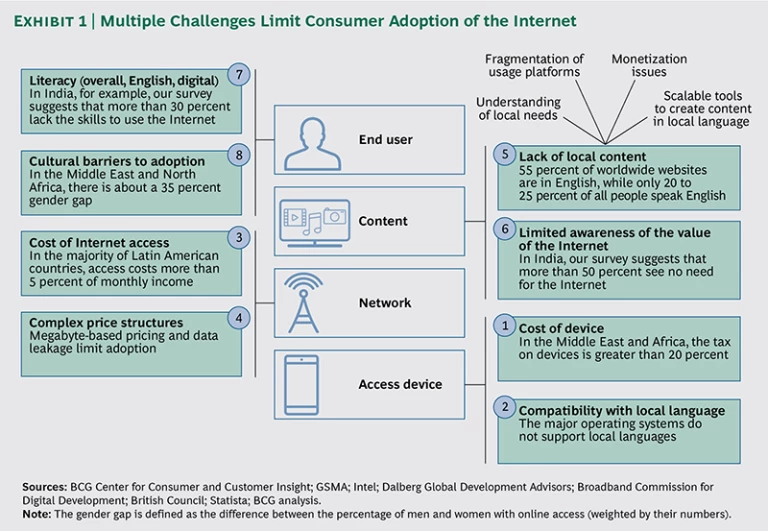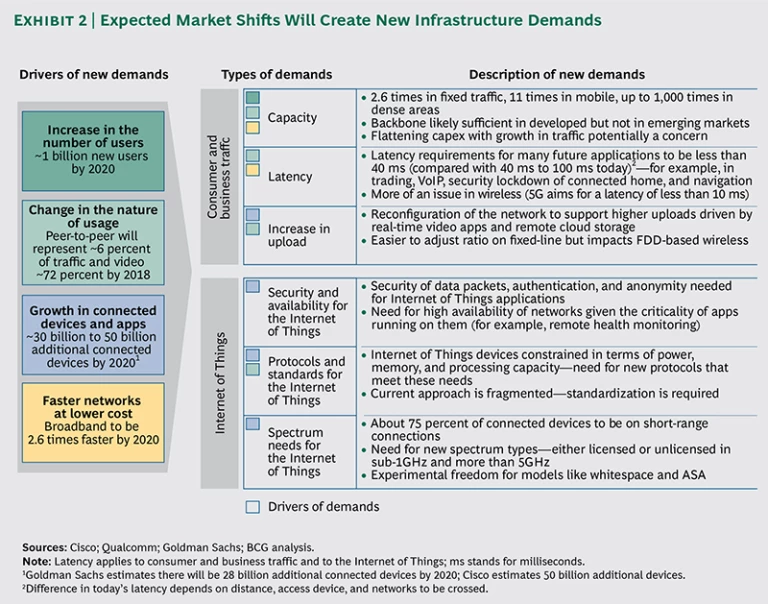The Internet already plays an indispensable role in the everyday life of billions. Yet the surface is only being scratched. The potential to bring new and more advantages to individuals around the world, and to benefit billions more people as they gain access, has few limits. Many of these benefits could have their biggest impact in emerging markets; unfortunately, these are the countries in which Internet penetration and use often lag.
Almost 3 billion connected consumers and businesses (as well as governments and other organizations) search, shop, socialize, transact, and interact every day using personal computers and, increasingly, a broadening range of mobile devices. The digital economy, which contributed $2.3 trillion to GDP in the G-20 in 2010 and is expected to contribute more than $4 trillion to their GDP in 2016, is growing at 10 percent a year—significantly faster than the global economy as a whole. The growth in the digital economy is even higher in developing markets: 15 to 25 percent per year. Around the world, the digital economy is an increasingly important source of jobs, and digital technologies are enabling far-reaching social and political changes as well.
As Internet penetration expands, connection speeds improve, and device prices fall, it is expected that there will be more than 1 billion new users by 2020. By then, the digital economy’s contribution to GDP in the G-20 is anticipated to reach $6.6 trillion a year, or 7.1 percent of total GDP in these nations. And these figures do not reflect the potential impact of the Internet of Things, which could connect between 30 billion and 50 billion additional devices by 2020, helping to operate everything from home-heating systems to automotive vehicles to jet aircraft.
The continued expansion of Internet penetration and use, and the long-term growth of the digital economy, depend on infrastructure. A new report by the World Economic Forum, written in collaboration with The Boston Consulting Group— Expanding Participation and Boosting Growth: The Infrastructure Needs of the Digital Economy —seeks to identify the most important challenges facing development of a healthy digital infrastructure for the years 2020 and thereafter in both developed and developing markets. It examines the particular challenges of bringing the economic and social benefits of connectivity to emerging markets, which were home to 96 percent of all nonusers of the Internet in 2014. The report builds on the broad recommendations of The World Economic Forum’s 2014 report (also written with BCG)— Delivering Digital Infrastructure —which explored serious obstacles to the continued growth of the digital economy over the subsequent three to five years, with an emphasis on the U.S. and Europe.
Complex Challenges
There are multiple challenges to be addressed. The issues are particularly thorny in emerging markets, thanks to economics that are often unfavorable, low population densities, low literacy rates, and lack of local digital content. In many such countries, two broad issues affect the ability to provide affordable Internet access: expanding network coverage and building network capacity.
Expanding Network Coverage. The economics of expanding network coverage are determined by a variety of factors, only some of which are related to technology. Population density, topography, distance from fiber connection points, and consumer purchasing power are all huge contributors to cost and revenue calculations. The economics of expanding coverage to especially poor and remote areas are often the most challenging, particularly using traditional business models. Ironically, it is for people living in these same areas that Internet access could have the greatest impact.
Building Network Capacity. Not being able to meet rising demand for network capacity is often an issue of lack of sufficient spectrum allocated to mobile use—because so many users in emerging markets access the Internet on mobile devices, and mobile is expected to be the predominant technology for billions of new users as well. Too often, policy makers and regulators focus on the short-term value of spectrum licenses rather than maximizing the use of this precious asset, and the result is a lack of available, affordable spectrum for mobile usage.
Encouraging Broader Internet Usage. Another critical challenge is to bring more people online, particularly in emerging markets. In many developed countries, there is a 30 to 50 percent difference between the number of people who have access to digital networks and the number who are actually online. In emerging markets, this gap jumps to 55 to 75 percent—and up to 90 percent in some cases. BCG’s research shows three main reasons for lack of adoption: perceived absence of need (resulting largely from lack of local-language content), followed by insufficient skills, with affordability as a distant third. Local content in local languages is vital for attracting local users and serving local needs. Governments also can help drive digital engagement with their own online services. (See Exhibit 1.)
Shifting Infrastructure Demands. Yet another challenge is that, in both developed and emerging markets, the changing nature of consumer and business usage and the rise of the Internet of Things raise new infrastructure demands. (See Exhibit 2.) As mobile data usage matures, low latency and far more uploads raise new challenges for network infrastructure. Moreover, the addition of 30 billion to 50 billion or more connected “things” over the next five years—while representing an enormous opportunity for economic expansion and growth—further expands the network infrastructure challenge. Meeting this challenge presents some unique spectrum requirements, such as more data being uploaded and data with mission-critical requirements, and increases the need for standardized and secure communication protocols.
Developing ICT Infrastructure for Smart Cities. Another key challenge is planning for and deploying information and communications technology (ICT) infrastructure for so-called smart cities. We anticipate that more than 1 billion people will move to cities—and some 360 new cities with populations of 500,000 or more will be created—over the next 15 years. We expect that almost 80 percent of these new cities will be in developing markets. In these areas, tools ranging from those that perform basic monitoring to advanced systems that enable predictive, analytics-based applications can all have a significant impact on citizens’ well-being and the efficiency of their daily lives.
Many of the ICT-based systems, apps, and services that can address urban needs—such as energy, transport, water and waste, social services, and building management and services—already exist. What many cities lack is a comprehensive vision for building the ICT infrastructure or for constructively using the massive data that it generates every day. The business cases for many ICT investments are complex, and it is difficult to finance large investments with payback periods that may extend over many years (sometimes a decade or more).
Facilitating Digital Data Usage. A final challenge relates to the increasing pervasiveness of digital technologies in everyday life. There is a growing need to unlock consumer and industry value by removing frictions that prevent users from transporting and accessing their data—particularly their personal data and digital identities—while continuing to respect user privacy and data security. Consumers have started to compile digital assets that are tied to their online lives and distributed across multiple sites, apps, and sectors. These data do not just include purchased digital content, but also government records, health care files, financial information,
and basic identity content, among other things.
This digital dependence gives rise to new issues with respect to the ability of consumers to easily access and use their data across devices, networks, and applications, while at the same time raising privacy and security concerns around the use of their data by others. Left unaddressed, unwarranted limitations on seamless or universal data use could come to constitute a serious barrier to people’s ability to get basic things done as well as to overall digital growth and economic activity.
Long-Term Solutions
Some challenges can be addressed in the next few years; others will require attention well into the next decade. While the market is generally the best mechanism for connecting consumers with technological and business innovations, there are also times when, and places in which, public-sector assistance can help, provided that the parameters of such assistance are clearly defined. All participants have roles to play in helping the digital economies in their countries take root and flourish in the following critical areas.
Developing a Comprehensive Country-Level Digital Agenda. Working with private-sector leaders and industry associations, governments (especially in emerging markets) should look to develop an overall digital agenda for their countries. The first step is for governments to determine the specifics of their broadband access aspirations. The second is for each government to determine a country-specific operating and funding approach.
The overall digital agenda should include near-term initiatives that will encourage investment from the private sector, generate tangible societal benefits, and engage citizens and consumers. It should also focus on a five- to ten-year vision that defines the nation’s broadband penetration—including a roadmap to connect all citizens, a definition of the role of different players, and an expectation of the market conditions that will help ensure success. The vision should include specific criteria for hard-to-reach and economically challenged regions and provide the criteria on which funding and operating models can be assessed.
Any specific plans for infrastructure construction or deployment should be technology agnostic, provide incentives for investment, and allow for experimentation, without creating market distortions. These plans also need to include measures for building digital demand and use—including education and training that help consumers acquire digital literacy and skills.
Promoting Investment. To further their comprehensive digital agendas, countries need policies that encourage network investments by all stakeholders, but especially by private industry. These policies should allow for experimentation with new business models (including consumer-pricing models) and further adoption of new low-cost technologies, such as small cells in urban areas and the technologies that advance the Internet of Things. Regulatory environments also need to evolve to facilitate and encourage investment.
Increasing Mobile Spectrum. Few policy undertakings have the potential for greater economic impact than optimizing policy on mobile spectrum allocation for long-term value; accelerating fair, market-based allocation of spectrum; and enabling more efficient utilization through spectrum-sharing regimes. Allocating more spectrum for mobile use helps countries achieve their digital agendas by making mobile access more affordable and attracting investment. The primary goal for policy makers and regulators should be to maximize the use—rather than the short-term value—of this scarce and precious asset.
Advancing Smart Cities. Governments can help move smart cities forward by determining the targets for long-term investment, creating the environments in which digital ecosystems can flourish, and providing regulatory frameworks that help ensure the necessary investment in infrastructure. They can take a lead role in planning, prioritizing, coordinating, and monitoring the development of smart cities—and in identifying and removing barriers, especially administrative roadblocks. They can pursue cross-department coordination and provide funding support where needed and also advance open-data policies, coordinate citizen involvement in “open-sourcing” ideas, and help ensure the scalability of smart city applications.
Furthering Universal Usage. As digital use increases across sectors, there may be a growing need for national policies, technical standards, and global guidelines that enable consumers to transport, access, and use data in multiple settings and jurisdictions without encountering significant barriers or compromising their privacy and security. The difficulties are complex, but the potential value—to consumers and industry alike—is astronomical. The vision to work toward should be based on an interoperable digital world in which the universal use of digital assets encounters the least possible amount of friction consistent with appropriate safeguards for consumers.
There are few areas in which governments can have a bigger impact than in helping to extend digital infrastructure and access throughout their countries. In order to accomplish these objectives, they need clear and ambitious long-term policies and goals. They should recognize the vital role of the private sector in bringing new technologies and other innovations to market. Governments’ approach to the marketplace should be light handed, and they should seek to limit distortion of free-market innovation and investment.
Governments face a challenging journey with few established roadmaps to follow. Experimentation will be essential. But no country should fail to capitalize on the potential of digital technologies to bring substantial improvement to human productivity and the quality of life.










